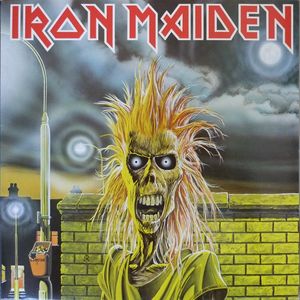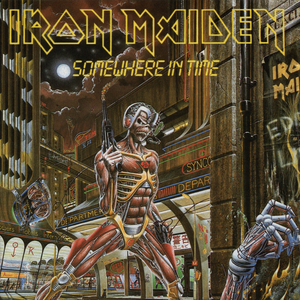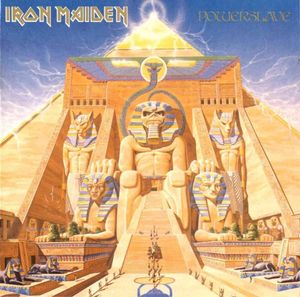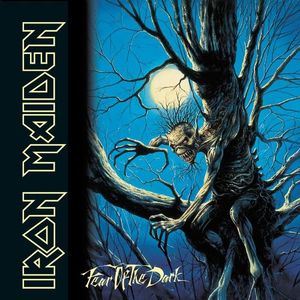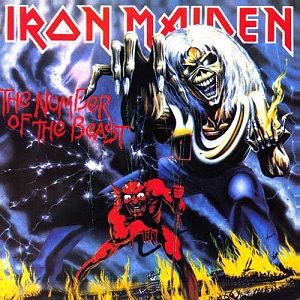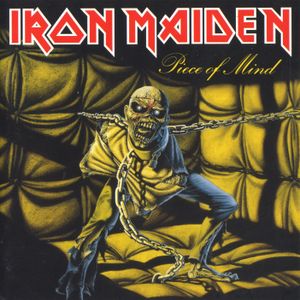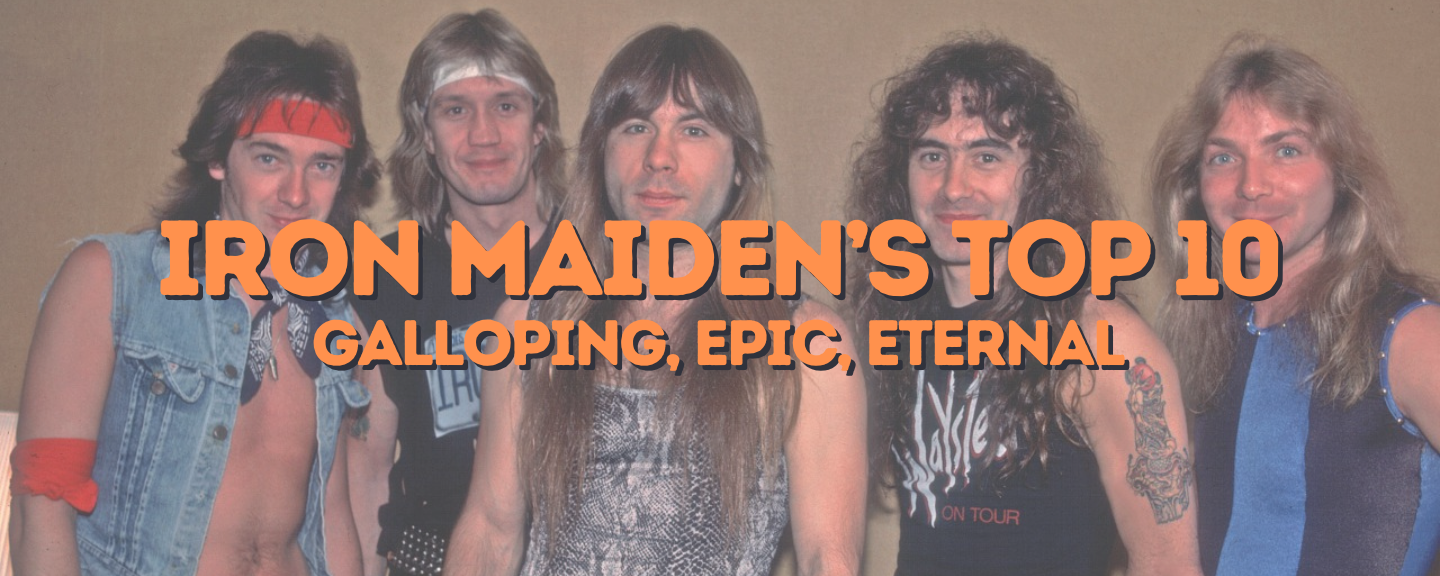
Iron Maiden’s Top 10: Galloping, Epic, Eternal
Click title to open the Spotify playlist
Iron Maiden: A Heavy Metal Legacy
Born in the crucible of Leyton, East London in 1975, Iron Maiden emerged as a force to be reckoned with, spearheaded by bassist and songwriting maestro Steve Harris. While their early lineup saw some shifts, the core of the band, consisting of Harris, lead vocalist Bruce Dickinson, drummer Nicko McBrain, and guitarists Dave Murray, Adrian Smith, and Janick Gers, has defined their sound for generations.
Iron Maiden were pioneers of the New Wave of British Heavy Metal (NWOBHM), a movement that shook the world of rock with its raw energy and aggression. Their early albums, including their 1980 debut and 1981's Killers, established their sonic blueprint, but it was 1982's The Number of the Beast, their first album with Bruce Dickinson, that truly catapulted them to legendary status. Dickinson's powerful vocals and theatrical stage presence ignited a firestorm, solidifying Iron Maiden's place as one of heavy metal's most influential bands.
The Number of the Beast became a cornerstone of the heavy metal canon, selling nearly 20 million copies worldwide. It was the catalyst for a string of platinum and gold albums, cementing Iron Maiden's position as a global phenomenon.
Despite internal turbulence in the 1990s, the band's resurgence in 1999, marked by Dickinson's return alongside guitarist Adrian Smith, signaled a new era of triumph. A slew of critically acclaimed albums and massive tours re-energized their fan base, proving that Iron Maiden's power was undiminished.
Their most recent albums – The Final Frontier (2010), The Book of Souls (2015), and Senjutsu (2021) – have all reached the top of the charts in over 25 countries, a testament to their enduring global appeal.
With over 130 million albums sold and 600 certifications worldwide, Iron Maiden have left an undeniable imprint on the world of rock. They are not just a band; they are a cultural icon, a force that has inspired countless musicians and continues to enthrall generations of fans. Their influence is immeasurable, and their place in the Rock and Roll Hall of Fame, alongside a plethora of industry awards, including Grammys and Brit Awards, is a testament to their enduring legacy. Iron Maiden is not simply a band; they are a testament to the enduring power of heavy metal.
For more than four decades Iron Maiden have flown the flag of heavy metal with Steve Harris’s trademark galloping bass, twin‑guitar harmonies, and Bruce Dickinson’s operatic roar—guided every step by their ever‑morphing mascot, Eddie. From battlefield charges to apocalyptic prophecies, the band fuse literature, history, and myth into songs that feel cinematic in scope and ferocious in execution. The ten tracks below chart Maiden’s evolution from NWOBHM trail‑blazers to stadium‑filling legends, capturing why their music still ignites mosh pits and inspires new generations of head‑bangers.
Our Selection Methodology
These songs were carefully selected based on cultural impact, musical innovation, streaming popularity, and their significance in the band's discography.
🏆 Top 3 Greatest Songs
Why "Phantom of the Opera" is #1
Clocking in at seven minutes on their debut, this multi‑section opus hinted at the prog‑metal path Maiden would later dominate. Galloping verses segue into dramatic instrumental passages, with Harris’s bass functioning as a third guitar. Paul Di’Anno’s gritty vocal adds punk snarl to gothic storytelling. Its complexity—tempo changes, key shifts, extended solos—made it a blueprint for future Maiden epics. Modern set‑list revivals prove the song’s raw NWOBHM energy still thrills, bridging early and classic eras.
Why "Wasted Years" is #2
Adrian Smith’s shimmering, tape‑loop intro riff instantly evokes nostalgia—a fitting mood for lyrics about homesickness on tour. Unlike Harris’s historical epics, “Wasted Years” is introspective, urging listeners to cherish the present rather than pine for the past. Bright major‑key choruses and a melodic, tapping‑infused solo reveal Maiden’s ability to write uplifting anthems without losing metallic edge. The song’s continued live popularity underscores the universal pull of its reflective message.
Why "2 Minutes to Midnight" is #3
A swaggering, palm‑muted riff and syncopated hi‑hat groove lay the foundation for Maiden’s cold‑war protest anthem. Smith’s co‑writing injects hard‑rock swing, while Harris counters with intricate chorus climbs, forging a perfect tension between accessibility and complexity. The Doomsday Clock metaphor and graphic imagery indict war profiteers, expanding Maiden’s lyrical palette. Its memorable chorus became a radio staple, proving political commentary could coexist with fist‑pumping hooks.
📊 Complete Rankings
Aces High
Churchill’s “Their finest hour” speech crackles over PA systems before Murray and Harris launch into a strafing‑run riff matching the song’s Spitfire dog‑fight narrative. Dickinson’s rapid‑fire verses and sky‑high sustained notes embody a pilot staring death in the face yet reveling in speed. Live, the band often opens with “Aces High” as an adrenaline detonator; the airborne imagery meshes with Dickinson’s real‑life pilot exploits, blending art and persona. The track’s seamless tempo shifts showcase Maiden’s growing progressive ambitions without sacrificing bite.
Fear of the Dark
An acoustic intro sets a moonlit mood before the full band erupts into a brisk, 7/8‑inflected gallop. Janick Gers’s wah‑drenched leads intertwine with Murray’s fluid lines, giving Maiden’s three‑guitar era early proof of concept. The lyrics tap primal childhood terrors, yet live crowds turn that fear into unity—thousands chanting the “whoa‑oh‑oh” refrain under festival floodlights. Its inclusion on every set list since ’92 shows the band’s ’90s work could stand shoulder to shoulder with their classic‑era canon.
The Number of the Beast
Vincent Price‑style narration, eerie guitar squeals, and a lurching time‑signature fake‑out open this quintessential horror anthem. The riff’s sinister swing pairs with apocalyptic lyrics drawn from John’s Revelation and ’70s devil‑films, igniting moral panics that only boosted record sales. Musically, it’s a masterclass in dynamics: verses creep, choruses explode, and a dual‑solo siege leaves listeners breathless. For many fans “The Number of the Beast” marks the moment metal found its theatrical perfect storm—melody, menace, and myth.
Run to the Hills
Opening with tribal tom‑toms that evoke Indigenous rhythms, the song pivots into a galloping major‑key riff—deceptively upbeat for a tale of colonial brutality. Verses switch perspectives between Native Americans and invading cavalry, showcasing early‑’80s metal tackling sociopolitical themes. Dickinson’s piercing high notes in the chorus deliver both anger and lament, while an extended middle‑eight solo captures the chaos of clashing worlds. “Run to the Hills” became Maiden’s first UK Top 10 single, broadening metal’s narrative possibilities and proving socially conscious lyrics could still shred.
Flight of Icarus
One of Maiden’s rare mid‑tempo singles, “Flight of Icarus” pairs a chunky, descending riff with Dickinson’s retelling of Greek myth from Icarus’s rebellious viewpoint. Producer Martin Birch’s emphasis on soaring vocals and punchy drums created a radio‑friendly mix without dulling the band’s heft. Though Bruce jokes the band “played it too slow,” the deliberate pace lets the melody breathe, becoming a sing‑along staple. The song illustrates Maiden’s knack for transforming ancient lore into arena metal, inspiring generations of metal bands to mine mythology for riffs.
The Trooper
Smith’s and Murray’s harmonized intro mimics bugle calls before Harris’s bass unleashes a cavalry charge inspired by Tennyson’s “Charge of the Light Brigade.” McBrain’s double‑time snare patterns imitate thundering hooves, while Dickinson belts battlefield imagery with relentless urgency. At concerts Bruce brandishes a Union Jack and fence‑duels Eddie, cementing the song’s status as a visual and sonic centerpiece. Its tight structure—riff, chorus, solo, repeat—illustrates Maiden’s ability to condense historical drama into four minutes of pure adrenaline, making “The Trooper” a mandatory lesson in heavy‑metal riff craft.
Hallowed Be Thy Name
A tolling bell, minor‑key arpeggios, and Harris’s expressive bass lines usher listeners into a condemned man’s final reflections. Over seven minutes the song ascends through tempo shifts, twin‑lead melodies, and a climactic solo trade‑off between Dave Murray and Adrian Smith. Nicko McBrain’s predecessor Clive Burr drives the crescendo with tumbling fills that heighten the drama. Lyrically, Bruce Dickinson narrates existential dread with Shakespearean flair: questions of fate, faith, and mortality swirl until the galloping outro feels like a soul breaking free. Often placed near the end of Maiden’s live sets, it turns arenas into communal chanting halls—proof that even metal’s heaviest moments can be spiritually elevating.
🎵 Why These Tracks Define Musical Excellence
This carefully curated ranking represents the pinnacle of Iron Maiden’s Top 10: Galloping, Epic, Eternal artistic achievement. Each song has earned its place through a combination of cultural impact, musical innovation, and enduring popularity among fans worldwide.
Cultural Impact
Songs that shaped music history and influenced countless artists
Fan Favorites
Tracks with millions of streams and lasting popularity across generations
Related Video
Last Modified: 5/8/2025

